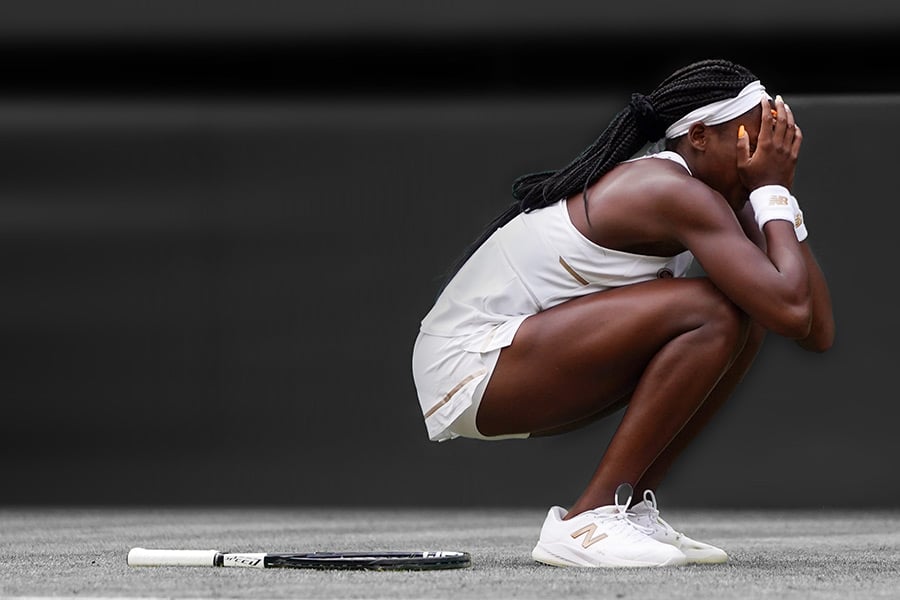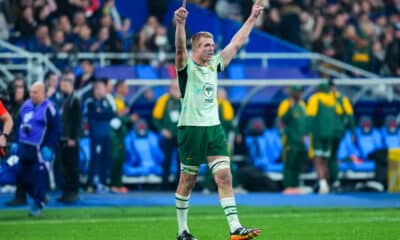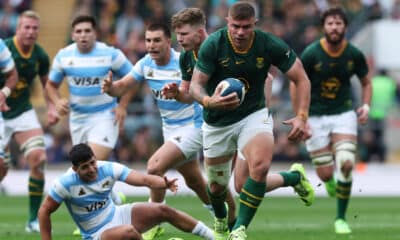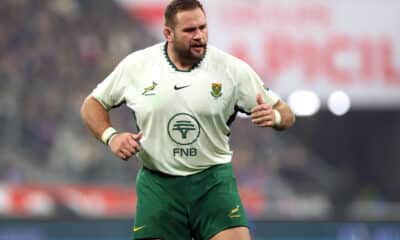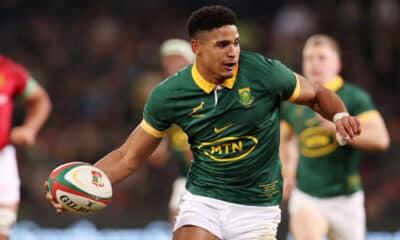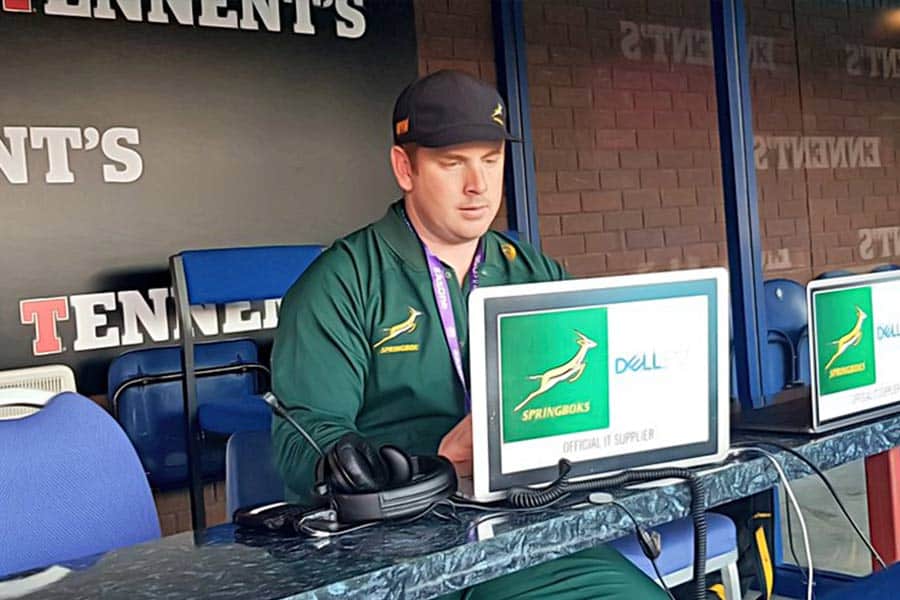
12 November 2019, by: SIBUSISO MJIKELISO
Behind The Springbok Success With Lindsay Weyer
ONE of the key figures in the Springboks’ heroic World Cup-winning campaign in Japan is an unassuming, yet cunning fellow that South Africa would have seen plenty times sitting next to head coach Rassie Erasmus’s right but paid him no mind.
GET THE ADVANTAGE WITH OUR RUGBY BETTING OFFERS
Extensive pre-match and live in-play markets on every game.
Our legendary BET Boosts to give you extra value on every game!
Exclusive to BET.co.za customers.
Springbok performance/technical analyst Lindsay Weyer was the coach’s extra pair of eyes – a trait honed during the decade served as a ball boy while his father Wayne played a record 183 times at flyhalf and fullback for Border Bulldogs.
“I’d say, ‘Kick here dad!’ Little things like that were awesome,” said Weyer.
“I’ve always had that rugby background and I always wanted to achieve the whole time. I wanted to make people happy.
“I was the ball boy there in East London for 10 years and I was there for John Smit’s first game (SA versus Canada in 2000) and the game where Tonderai Chavhanga scored a record six tries for the Springboks (against Uruguay).
“I was there when the Sharks would have some of their home games there. Just watching my dad play rugby was awesome. I’ll never forget running down the touchline as a ball boy and giving him a cue of where to kick for touch.
“My dad has never sent me so many messages saying how proud he was of me.”
In one of the most endearing and enduring images that trended during and after South Africa’s 32-12 win over England, injured tighthead Trevor Nyakane can be seen jumping in jubilation alongside Jesse Kriel as the Boks demolish the English scrum on the tortured Yokohama earth.
In the foreground of the image, Weyer is unmoved, unshaken and unflustered. He has an ice-cold view of the game, which is almost like seeing a sniper load his rifle before aiming at the target.
He has watched reams and reams of footage and what the public sees is often the end product of hours of planning that he – Erasmus and the rest of the coaching staff that includes Mzwandile Stick (skills), Jacques Nienaber (defence), Matt Proudfoot (forwards) and Aled Walters (athletic performance/conditioning) – has agonised over.
I can’t explain the amount of work that goes on behind the scenes from the incredible Springbok management team. Here’s to two of the hardest working men, coach Mzwandile Stick and Technical analyst Lindsay Weyer. @mtnza @Springboks #WeGotUBokke?????? pic.twitter.com/EAtSrtlGP6
— The Official MTN Bozza (@Official_Bozza) August 11, 2019
What he relished most in this group of world-beaters was the enthusiasm for continuous learning that they showed throughout the process.
“In my department, I love it when guys bug me and not vice-versa,” the 31-year-old said.
“Normally I’m the one that says, here’s the game or are you looking at this or that. But I’m not there to be a teacher or something like that. I want engagement. Then you know they are really in it and they are looking at it from a different perspective.
“Guys like Handre Pollard, Jesse, Lood de Jager, Malcolm Marx, Elton Jantjies and the nines, are usually the ones keen to come to me and have a chat and to draw up plans. I’ve sat with Handre drawing up maps and having great discussions.”
The Bok defence was a big bugbear in the 18 months leading up to the victorious campaign in Japan. But, as Weyer explained, they never had any doubt that the system, which had everyone dubious after the tight England series in June last year, that Nienaber put together.
“We said: ‘Listen boys, let’s back the system. Trust us, this is gonna win us the World Cup. That was back then already,” he added.
“Give credit to Jacques. He never created doubt amongst the players. Then he made it pretty simple: firstly, get your width on defence, then secondly line speed and lastly, make the hit or make the read.
“In the initial stages, we were sometimes getting caught when we were too tight and we weren’t getting that width. In last year’s England series it was still early days for us and they made Lukhanyo Am and Aphiwe Dyantyi look very vulnerable.
“They didn’t score through us, they scored around us. It was a good learning curve for us.
“Everyone thought they were making the wrong decisions but that was our plan. We were never going to change it and we had to back it. If you create doubt amongst the players or the coaching staff then you’ve lost that battle already. Then there’s going to be uncertainty. There’s going to be 50-50 decisions.
“At that line speed you can’t hesitate; you have to make the read regardless. If they want to throw it over the top, that’s a 50-50 pass the opposition will have to make. The opposition will have to do a miracle pass or miracle kick.”
The Springboks’ 36-34 win over New Zealand in Wellington was the game that set the marker for the World Cup success. Not only did it inject belief in the Boks, but it also cracked open the sluice gates of doubt in the All Black setup.
It forced Steve Hansen to question himself and his team. Suddenly, Beauden Barrett was dramatically shifted to fullback from flyhalf to accommodate Richie Mo’unga. Ben Smith and Rieko Ioane were unceremoniously dropped for Sevu Reece and George Bridge and 100-Test veteran Owen Franks was surplus to requirements.
“The best No 10 in the world is Beauden Barrett but we possibly forced the change for him to play at 15,” Weyer said.
“I honestly feel we did. He looked average against a rush defence.
“He was never the same person after that Wellington Test match after we beat the All Blacks there last year. He was nowhere to be seen. They put Barrett at 15 because there’s more space and time, which is what he likes.”
It was these and other small victories along the way that turned little known people like Weyer, from little old towns like East London, that culminated in South Africa’s most important sporting victory of this millennium.
JOIN BET.CO.ZA NOW AND GET 100% DEPOSIT MATCH UP TO R1000
Open your BET.co.za account here
Deposit using your preferred method
Your bonus gets added immediately!
MORE RUGBY




